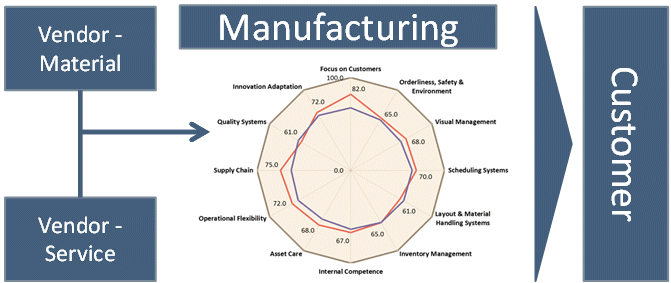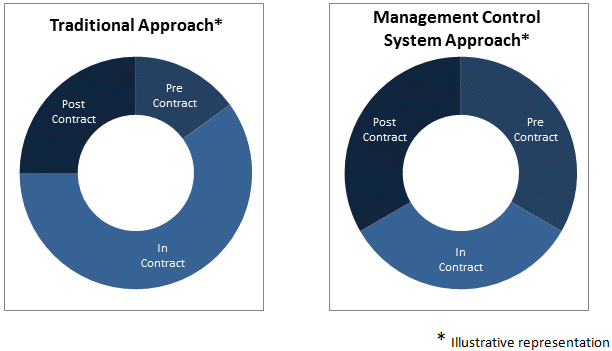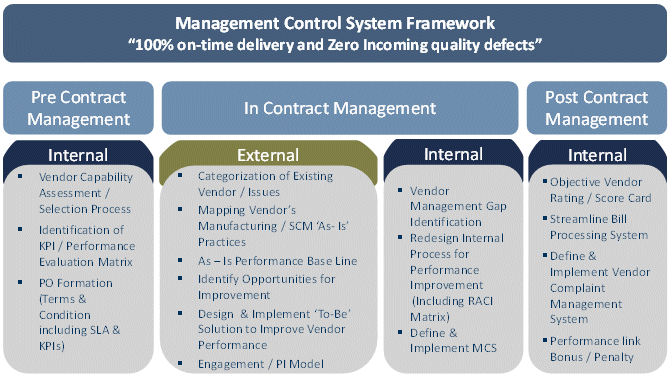Abstract
Effective vendor management is one of the imperative aspects of organizational success. In a progressively competitive market, vendor partnerships can offer significant advantages on multiple fronts which directly impact the organizational value offerings. However, ineffective control over vendor relationships may expose the organization to financial and notoriety hazard.
Outsourced materials and services are having an intense impact on final product quality. Any weakness in the overall organization manufacturing practices can create a ripple effect and transferred the vendor defects to the end users and finally negatively impact the Top-Line , Bottom-Line as well as reputation of the organization.

Three fundamental pillars of vendor management are Process, System, and Structure. These pillars are recognized to ensure success between a manufacturer and vendor and hence third party relationship model. In order to achieve optimum effectiveness of an outsourcing model, both vendor and manufacturer need to work as single team toward a unified objective, However, it is not uncommon top management witness managers and vendors at loggerheads for a variety of reasons.

In the present context, organizations are adopting various automated platforms to strengthen their vendor management practices. Without doubt, these technologies are helping organizations not only to streamline their vendor management process but also to enable them enhance the overall supply chain efficiency. Although these technologies have certain advantages, there are ample opportunities in terms of fundamental Management Control System to improve vendor management practices. Some of the critical aspects where weakness are generally observed are Outsourcing Need Identification, Ambiguity in Job Definition, Fragmented Supplier Base, Multiple Contacts, Total Cost Assessment, Stakeholder Coordination, Risk Assessment, Performance Management, Contractor Scorecard.
Improper process deployment, subjective review mechanism, and an inadequate RACI can hamper any vendor management system. Innovation technologies are of great help of our age but this fundamental trinity will prevent value pilferage and ensure strong foundation for growth strategic initiatives.
The fourth industrial revolution has already begun. In order to sustain presence and competitiveness, organizations are also transforming their business models. Appropriate preparation with strong management control system will be instrumental to embrace the change.
The fundamentals of vendor management start at the pre-contact management stage. Ambiguity in job or requirement description disrupts the successive stages. A well-defined job scoping exercise, with agreed stage wise SLAs, KPIs and review mechanism establish an expectation with comprehensible terms.
Organizations are required to create a robust and transparent framework for both the internal and external process. Each layer of this framework should have clear defined process and control mechanisms. It is also important to consider equal weightages for pre-contract, in-contract, and post-contract aspects of vendor management. It is also crucial to setting up a two-way feedback mechanism between both parties to ensure the end product’s success.

Cost Effectiveness or Vendor Maturity, Responsiveness or Quality, Flexibility or Brand Value are the common challenges of the decision making process. In most cases, supply chain managers are constrained by numerous components, such as cost, perception, and clarity on requirement. In light of these limited conditions, different variables are frequently introduced that lead to value spillages. Given priority to the different business models and complexity, defining a static management control system is not possible. However, the basics of management control system remain same across the industries and geographies.

Key Focus areas of Vendor Management Control System: Job Scoping, Cost Model, SLA & KPI, RACI Matrix, Vendor Evaluation (Pre & Post Contact), Vendor Selection, Review Mechanism (In Contact), CAPA, Interdepartmental & Vendor Coordination, Job Evaluation, Regulatory, Environment
Procurement costs (direct and indirect) are managed through robust financial controls and historically these measures are enabling organizations to attain their financial commitments. In the journey of transformation from third party vendor to partnership models, the supplier management now extends far beyond from its traditional objectives. The primary difference between a traditional procurement and modern vendor partnership model is active engagement of vendor to enhance value, reduce risk and improve delivery and quality performance. Transformation from reactive management to planned vendor management can be achieved by leveraging Fundamental Management Control System and Innovation Technologies. Effective implementation of well-defined vendor management frameworks will assist an organization to not only reap complete benefits from vendor partnerships but also enable both parties to be in a position to achieve tangible and intangible advantages and mitigate associate risks.



